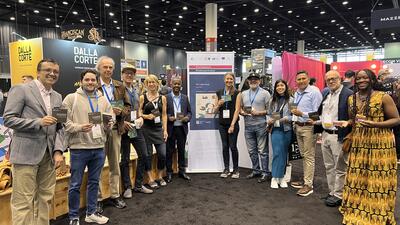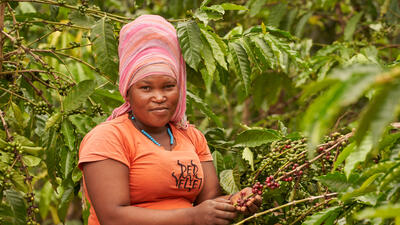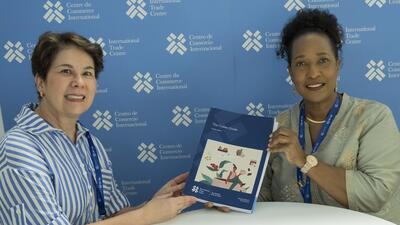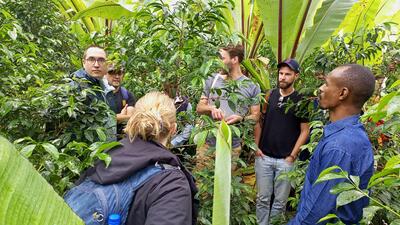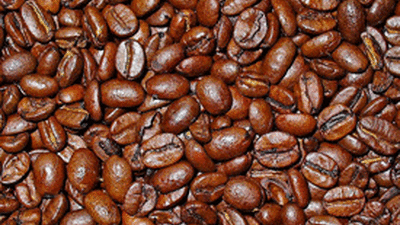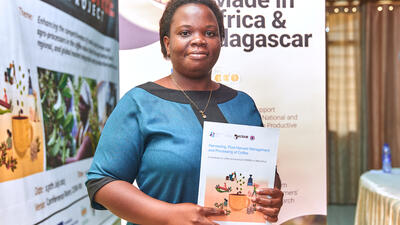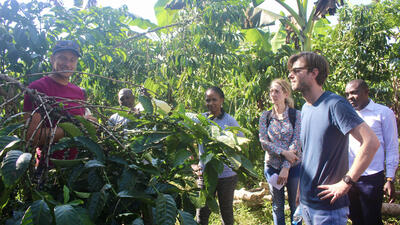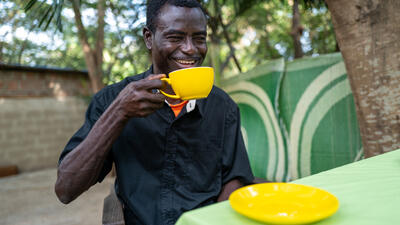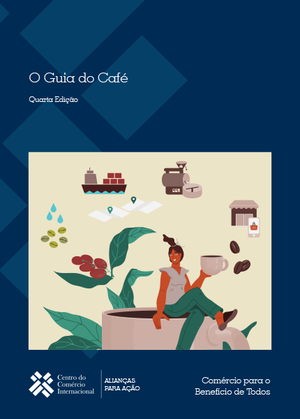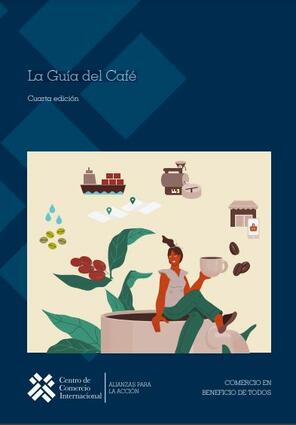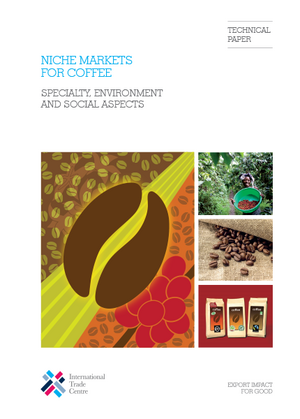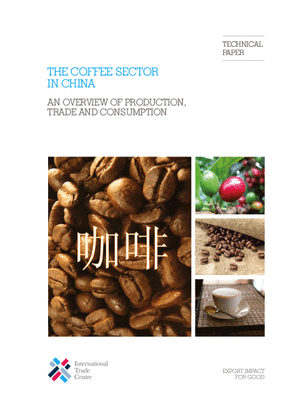

Digital Transformation
Q&A with an Expert
A quick chat with Elisa Criscione, Founder and CEO of Digital Coffee Future.
Digitalization across the Coffee Sector
Coffee played an important role in the development of the modern information age by fuelling the late-night sessions of programmers and software developers. Tributes to the influence of coffee are paid in such tech names as Java, JavaScript and CoffeeScript.
Now, tech is repaying the favour by helping farmers, producers, traders and coffee drinkers to create better coffee, from seed to cup. Digital technology also enables players across the coffee supply chain to work more efficiently, reach new markets and function more equitably and sustainably.
Digital technology bolsters the competitiveness of the coffee sector as a whole. Digitalization enhances the three Ts of transparency, traceability and trust across the supply chain. It opens up new funding opportunities, such as impact investment, which seeks social or environmental gains as well as profits. Sustainable digitalization has become a priority of public policy with the emergence of corporate sustainable due diligence regulations. The new mandatory measures will require proof of compliance and new levels of traceability, transparency and data management that will inevitably require investment in digital technologies.
The large volumes of data being generated by the agricultural sector, including coffee, present opportunities for Big Data. This is causing a shift in the sector. The insights acquired from mining the mountains of available data make it easier to tackle even the inherent uncertainties in the coffee sector.
Opportunities bring risks, however. While digitalization offers the promise of greater accessibility, it also widens inequalities. This risk is especially high in the coffee sector, where inequalities along the supply chain are already substantial and the poorer players often lack the resources to take full advantage of the opportunities on offer.
That said, digitalization also presents a promising pathway to greater fairness, sustainability and durability. For that to happen, policymakers, donors and investors must be aware of opportunities and risks. They must invest in structural reforms, infrastructure and capacity building.
This toolkit explores digitalization across the value chain: at production, trade and processing levels. Explore examples of digital tools across the value chain below, get inspired with case studies, and check out our go-to resources.
For an even deeper dive on digitalization’s influence in the coffee sector, read Chapter 4 of the Coffee Guide here.

Digital Solutions across the coffee sector
The digital products and platforms referenced are not exhaustive, they simply offer a taste of what exists on the market. Digital solutions are wide and varied, and new products and initiatives are popping up almost daily, in the fast-paced technological landscape. We invite you to explore these. This list includes examples of sustainable farms and supply chain management software from Brazil, with the help of Brazil Specialty Coffee Association.
New technologies help farmers to grow better coffee, and to adapt to global warming challenges and other environmental problems. A growing spectrum of tools, technologies and platforms is available to farmers today. However, many remain too costly for smallholder farmers or those operating in poorer countries. There is a digital divide to consider, and cost, infrastructure and technical literacy are systemic realities that need to be addressed before turning to technology as a solution.
SOME DIGITAL SOLUTIONS AT FARM LEVEL
Agronomy: Soil analysis
Given the importance of soil for coffee cultivation, science and technology play a significant role in helping farmers turn their soil into fertile ground. In Brazil, for instance, the government believes the country’s success as a coffee-producing nation is largely down to effective soil analysis, particle physics, chemistry and biology.134 Accurate, timely soil analysis helps farmers maximize yields and minimize fertilizers. Such analysis has been out of reach or too expensive for most smaller farmers or farmers in developing countries. Some specialists estimate that as few as 10% of the world’s farmers enjoy access to laboratories, which are usually too far away and/or too costly to use.
-
Satellite technology for ‘precision agriculture’
Land-use monitoring is a new trend in satellite use. Observation data, maps and imagery are being used in an emerging field known as ‘precision agriculture’, ‘satellite farming’ or ‘site-specific crop management’. Precision agriculture complements the ground-level technologies to analyze and monitor soil and crop yields. It uses information gleaned from space or from unmanned drones in the sky to support decisions made at the level of the farm and region. Because earth observation technologies and geographical information systems are expensive, initial forays into precision agriculture focused on crops with faster cycles. That said, satellite technologies are making inroads into the coffee sector especially through family farms and estates, as growers increasingly become aware of the medium- to long-term benefits. One company in Brazil that has been a trailblazer is O’Coffee, which has used satellite technology to monitor hundreds of acres of coffee farms for the better part of a decade.
-
Tools for farm management
Technology also helps to manage farms. Available solutions enable farmers and plantations to monitor fields, arrange harvests, store crops, manage suppliers and customers, buy supplies, sell produce, carry out quality control and optimize bean storage. They also help farmers with day-to-day business functions such as accounting and payroll. Among the proliferation of market solutions, many are prohibitively expensive for small coffee farmers. In addition, as with agronomical technologies, many farmers are unaware of their existence or lack the skills and know-how to use them effectively. Some software offers what is marketed as complete and integrated farm management solutions. An example is Amity Software’s agriculture management software system. This software targets agribusinesses with modules on land acquisition and preparation, crop management, dispatch and delivery, and post-delivery operations.
Technological solutions |
User groups |
Description |
|
Agrocares Kahawa Soil Test |
Farmers |
Monitors soil parameters and produces soil reports, aiming to increase soil quality and fertility. Uses nutrient intelligence. |
|
Amity Software |
Agribusiness
|
Agriculture management software system. It contains modules on land acquisition and preparation, crop management, dispatch and delivery, as well as post-delivery operations. |
|
Cropio |
Farmers
|
Field management system that supports remote monitoring of agricultural land. |
|
Cropster Origin |
Farmers |
A complete information management system covering the entire process from production to sample profiling. It allows users to record and track coffee bean lots, monitor the processing and storage environment, compare the quality of different batches and samples, and share data with customers. |
|
Earth-i |
Farmers |
Monitors local weather patterns and delivers geospatial information, (for example, optimal locations and times for coffee growing). Uses satellite technology and geospatial intelligence. |
|
Innovakit |
Farmers |
Offers tools for harvesting and growing, such as refractometers, which measure the amount of dissolved solids, solar dryers, fermentation systems, pH meters, temperature and humidity sensors, as well as waste treatment systems. |
|
Global Farm |
Farmers |
Offers a complete farm management solution that enables producers to maximize productivity and profitability. |
|
Educampo |
Farmers |
A platform created by Sebrae (a government body, roughly translated, Brazilian Micro- and Small-Business Support Service) to support coffee producers through education and integration with other players in the coffee value chain. |
|
Enveritas |
Traders and Roasters |
Deforestation detection using high resolution satellite imagery. |
SOME DIGITAL SOLUTIONS AT LOGISTICS LEVEL
-
Digital platforms for shipping and paperwork
Platforms exist that enable coffee farmers and roasters to organize produce transport and manage export and import paperwork, lightening the bureaucratic burden on both producers and buyers, especially small coffee farmers without export experience. However, available solutions have drawbacks. Platforms may discourage farmers by stipulating that they must be registered users of the platform before their coffee can be transported. In addition, these services can be expensive when small shipment sizes are involved, leading to an increase in the final coffee price. Algrano offers just such a service. This platform allows coffee exporters to find either shared or dedicated shipping solutions, depending on the size of their shipment. Exporters can calculate shipping costs and order the shipping from the comfort of their desks.
|
The coffee supply chain is, by its very nature, very long and very complex, involving multiple players, from coffee growers and millers all the way down to distributors and retailers. Transparency is essential to guarantee that the coffee has been grown and traded to the required quality, environmental, economic and social standards. Traceability is also vital for the various certification initiatives, such as those guaranteeing fair trade, organic farming, rainforest protection and bird-friendly agriculture. Digital technologies can and do offer powerful solutions that better integrate the coffee supply chain and enhance traceability along it.
SOME DIGITAL SOLUTIONS AT MARKET INFORMATION LEVEL
-
Blockchain technology
Blockchain is essentially an electronic ledger. It is distributed between multiple players, encrypted and unalterable. This makes it more transparent and reliable than a traditional paper ledger.
Blockchain technology offers a versatile, powerful, reliable and unhackable method for tracing and tracking coffee along the entire supply chain. Rather than a string of unconnected records kept by each player in the supply chain, blockchain enables a single unique, unmodifiable ledger to be created for each batch of coffee that starts with the farmer and ends with the consumer. Blockchain systems can also complement the virtual marketplace platforms outlined in the previous section. Although blockchain-distributed ledgers empower farmers, they also greatly increase their administrative burden.
Technological solutions |
User groups |
Description |
|
M-Cultivo |
Farmers, mills and cooperatives |
Mobile messaging platform that includes automated daily SMS and WhatsApp messages with price offerings and other relevant information. |
|
Farmer Connect |
Farmers, importers, consumers |
End-to-end traceability platform that uses blockchain technology to empower coffee farmers to take greater control over their sales and to gain a greater share of the profits, and to enable consumers to trace the coffee they purchase all the way back to its source. |
|
Thank My Farmer |
Farmers and consumers |
Uses IBM block chain technology to allow drinkers to trace their coffee, raising their awareness of its quality and origin. It also allows them to support the farmers who grew the beans. |
A great geographical distance separates coffee growers from coffee consumers. Traditionally, this required a long chain of go-betweens, sellers, buyers and intermediate markets. Digital technologies are helping to shrink that distance. They offer coffee farmers, roasters and traders new opportunities to link up directly with coffee buyers, such as green bean marketplaces, and blockchain. During the pandemic the trend towards distributing coffee through e-commerce channels picked up speed to offset falling sales in coffee shops and cafes.
SOME DIGITAL SOLUTIONS AT E-COMMERCE LEVEL
-
Direct sales
Algrano, a Swiss start-up established in 2015, runs a virtual marketplace linking coffee growers directly with roasters. The platform provides coffee farmers with direct access to new markets in Europe and enables European roasters to contact growers directly and easily. More than 600 registered growers and 700 registered roasters use Algrano. Vollers Group runs the V-Hub green coffee marketplace, which hosts electronic ‘shops’ for sellers and buyers of green coffee beans.158 Vetted traders can set up a public profile for their company and provide real-time information on the beans they have on offer. Thanks to the detailed data available, buyers who join the system can search for coffee beans by flavour, region of origin, coffee varietal, processing method and certification. The system also includes maps and real-time location information.
-
Online marketplaces
Virtual marketplaces have blossomed in recent years, especially for the specialized segment. They reduce distribution costs, increase growers’ profit margins, provide buyers with a wider selection of beans and cut delivery times. These platforms also have disadvantages. One drawback is that they remove personal relationships – often built up over years of direct contact – between coffee growers and distributors. Another challenge with e-markets is that they require digital literacy on the part of farmers, as well as extra work to set up and manage online presence.
-
Online auctions
Online auctions offer coffee farmers and traders a way to sell their produce to the highest bidder, potentially generating greater revenue and increasing their profit margins. One successful initiative is the Alliance for Coffee Excellence’s Cup of Excellence auctions. Launched in 1999, the Cup of Excellence not only allows coffee growers to receive top dollar for their beans, but its exacting standards ensure the highest standards for coffee buyers. The Cup of Excellence helps farmers develop cutting-edge skills and organizes competitions and competitive auctions that recognize and reward the excellence achieved by individual farmers. Thousands of growers submit their coffee to the Cup of Excellence each year. The winning entries are placed on a global online auction through the digital platform M-Cultivo and sold at premium prices.
Technological solutions |
User groups |
Description |
|
Algrano |
Farmers and roasters |
A virtual marketplace linking coffee growers directly with roasters. |
|
Beyco (Beyond Coffee) |
Farmers, roasters, traders, producer organizations |
Coffee connection and trading platform based on blockchain technology. Beyco links sellers with buyers. |
|
V-Hub |
Green coffee sellers and specialty coffee roasters |
Hosts a number of electronic ‘shops’ for green coffee bean sellers and buyers. Vetted traders can set up a public profile for their company and provide real-time information on the beans they have on offer. |
|
Alliance of Coffee Excellence: Cup of Excellence auctions |
Farmers |
Competition and auction for high-quality coffees using M-Cultivo platform. |
|
EcropOrigin and its Coffee Connection Application |
Farmers, importers, traders and roasters |
Software to schedule and log work on the farm, track inventory, harvests and processing, connect with buyers, manage shipping and trace origins. The Coffee Connection Application provides traceability and increases transparency to help verify authenticity along the coffee supply chain. |
|
iFinca |
All actors of the value chain |
The blockchain app connects farmers to global markets. It enables validation and verification at every step of the supply chain. |
|
Flowins |
Farmers, importers, traders, and roasters |
Flowins was founded in 2018 by two Brazilians to help producers grow coffee more efficiently and sustainably and to facilitate market access. Subscription based software offers sensory analysis tracking, direct trade sales, traceability, and agricultural technical support. |
Until recently, smallholder farmers and those in remote locations were largely excluded from the banking system, including e-banking. In addition, many small farmers do not trust banks or fully comprehend the benefits of banking services. However, digital and telecommunications technologies enable a growing number of coffee farmers to benefit from modern banking system services, including digital wallets, digital bank accounts, credit and financial support.
SOME DIGITAL SOLUTIONS AT FINANCIAL LEVEL
-
Digital banking
Digital banking services targeting smaller farmers, including coffee growers, have emerged in recent years. In 2007, the Colombian Coffee Growers Federation introduced its Smart Coffee ID Card, which acts as both a federation membership card and Bank of Bogotá banking card. By 2014, 5.4 million transactions worth nearly $750 million had been carried out using it. Although the Smart Coffee ID Card was designed as a safe and simple method to pay farmers for their coffee harvests, it rapidly evolved to become a channel for the distribution of incentives, government subsidies, credits and resources, the federation says. In addition, coffee growers can use the smart card to access automated teller machines and pay for purchases from provision warehouses, cooperatives and selected commercial outlets. This made transactions safer for farmers by reducing the need to carry cash.
The pandemic brought unique challenges that can be addressed through digitization. This has led to a redoubled drive to expand digital banking access to coffee farmers. In the Philippines, for instance, Rizal Bank has been working to sign up 50,000 coffee farmers to its financial inclusion app, DiskarTech. The application provides each farmer with a unique QR code to accept direct cashless payments. These are then deposited into a savings account that, as of August 2020, earned 3.25% interest.15
-
Mobile banking
Among the first banking services for poorer farmers, especially in Africa, were simple e-wallets on mobile phones. These were usually established and run by telecom companies rather than traditional banks. The service allowed them to pay for goods and services and receive payment for their produce. This was especially the case in sub-Saharan Africa, where the penetration of conventional banking – not just for farmers, but also for the population as a whole – was low. Mobile phone-based money transfer services entered to fill the void. For example, using core technology developed by a Kenyan student and rolled out by Vodafone’s Safaricom subsidiary, M-Pesa was launched in Kenya in 2007 to enable people without a bank account to transfer money. The technology was quickly adopted in the rest of East Africa before spreading rapidly to other parts of the continent, reaching some 30 million users in 10 countries. Despite the convenience of mobile phone systems such as M-Pesa, the charges that users pay to send or withdraw money add to the cost of doing business.
Technological solutions |
User groups |
Description |
|
FarmDrive |
Farmers |
Allows African farmers to keep financial records. It has also developed its own proprietary lending engine to enable them to access credit and apply for loans. |
|
Smart Coffee ID Card by the Colombian Coffee Growers |
Farmers |
Launched in partnership with Bank of Bogotá, it acts as both the Colombian Coffee Growers membership card and prepaid payment card. It replaces cash as a mode to make procurement payments to coffee growers, distribute government subsidies and credits, make savings and pay salaries. Coffee growers can use the card to access their funds at ATMs or special point-of-sale devices deployed by the bank at coffee purchase points and with rural merchants. |
|
DiskarTech |
Farmers |
Financial application from the Rizal Commercial Banking cooperation that provides financial services to unbanked Filipinos. Has been working to sign up 50,000 coffee farmers. |
|
Vinculum |
Farmers |
A fintech solution for smallholder farmers that uses artificial intelligence to identify and extend financing based on farmer potential. |
SOME DIGITAL SOLUTIONS AT PROCESSING LEVEL
-
Precision roasting technologies
New technologies are transforming the roasting of coffee beans from an art form into a science. Whereas coffee roasters previously relied on guesswork and crude measurements, new integrated systems allow for the monitoring and adjusting of every tiny detail of the roasting process.
Coffee roasting machines have become smaller, cheaper, more consistent, programmable and versatile. For example, the Behmor 2000AB Plus is about the size of a kitchen oven and can be used by producers to develop and taste their own samples. Though coffee roasters like this are cheaper than their industrial rivals, they are still beyond the means of many coffee growers, especially small-scale farmers. Also, few growers see the advantage of roasting their own coffee. Ikawa has gone even smaller. It has developed a micro coffee roaster, for both professional and home use, that can be programmed and fine-tuned. London-based Ikawa has also created an online community where roasters can share their recipes and roasting curves. Some smaller farmers have invested in this type of small-scale roasting technology to enable them to experiment with the flavours of coffee beans that are more resilient to global warming and pests.
-
Automating roasting
A major innovation in roasting technology has been platforms that use sensors in roasting machines to monitor, control and automate roasting. The Cropster platform now counts thousands of users, from professional roasting businesses, from garage roasters to suppliers of major brands. Cropster’s tools are connectable to roasting machines and provide roasters with split-second control over the roasting process. Roasting results are automatically tied to samples and lots, as well as to sensorial and physical quality characteristics, thereby providing traceability regarding coffee origins and quality. Cropster’s longer-term vision involves encouraging farmers to gather quality-relevant coffee bean information, and access better markets and partners in the coffee value chain. This includes tools such as Cropster Roast and Cropster Lab, which collect and share data about coffee samples, including origin, grading, sensorial and roasting information. Additionally, Cropster Origin helps farmers who sell green coffee to connect directly with roasters. While Cropster charges coffee roasters a fee for its software and professional support, some free, open-source alternatives exist for those unable to pay for these services. One example is Artisan, installed by thousands of users around the world, including new and experienced roasters as well as home hobbyists. Being open source, the app has evolved with the active input of its community of users and developers. Available in 20 languages, Artisan can work with more than 30 types of roasting machines and over 50 associated devices. In addition to helping manage and control the roasting process, Artisan also provides a roast simulator that enables roasters to test out ideas without wasting too many beans.
-
Cupping technologies
Cropster Cup is a cupping app integrated into the Cropster solutions environment. It ties cupping results directly to lots, samples and roasts, and provides comparative visual reporting. Built-in sharing mechanisms facilitate communication between coffee buyers and sellers, including international coffee auctions, import and export businesses, and producer organizations.
The app Tastify attempts to standardize cupping protocols to ease comparisons and rankings. It allows cuppers to record and document their cupping experience and share it with others around the world. The resulting database is useful to both roasters and buyers on the lookout for a particular flavour profile. Exporters can use their comparative score as a selling point to attract importers, while importers can use the app to inform their buyers about the cupping scores of a particular source.
Similarly, Open Cup is an app that lets the user create customized profiles of each cupping experience and compare them with other evaluations. Angels’ Cup is similar to Tastify and Open Cup but aims more at hobbyists and ‘coffee geekdom’. It enables consumers to record and share coffee-tasting notes and find their ideal coffee blend. Although these apps provide powerful tools for sharing and standardizing quality evaluations, they cannot and do not replace the skill of roasters, who are the ultimate determiners of coffee quality.
-
Brewing technologies
Creating the perfect coffee brew involves knowledge, skill, artwork and a sprinkling of magic. Digital tech can provide a helping hand. Modern brewing technologies provide tools to aid in the design of coffee preparation processes that extract the desired aromas, tastes and solubles from the coffee beans. They are used to develop recipes, manage the brewing process and evaluate the quality of the produced beverage. These technologies help standardize desired parameters and ensure consistent quality across cups. Most platforms on the market focus on recipe creation, sensorial analysis and quantitative measurements, as well as quality and consistency management. As useful as these technologies are, few are designed for scalability and the hectic pace of busy modern cafes. The processes consume too much time or are not easily repeatable across batches. Moreover, they are often not integrated back into the coffee supply chain. Consequently, they do not yet deliver the valuable insights that can be achieved through the sharing of information on quality and charting the correlation between roast and origin parameters.
Technological solutions |
User groups |
Description |
|
Artisan |
Roasters |
An open-source software that helps coffee roasters record, analyse and control roast profiles. The software can automate the creation of roasting metrics to help make decisions that influence the final coffee flavour. |
|
Cropster |
Roasters |
Allows roasters to profile, plan, automate and track during the roast process. It includes a state-of-the-art roast profiler, artificial intelligence-powered roast curve prediction, roast curve and cupping comparison tools, and a built-in production scheduler. |
|
Ikawa |
Roasters and consumers |
A digital micro-roaster whose app offers a simple way to roast coffee. Moreover, it offers recommended roast recipes, tailored to each coffee. |
|
Angels Cup |
Cuppers |
The app allows recording of tasting notes and compares answers with the Angels Cup community and the roast master. |
|
Open Cup |
Cuppers |
Used by cuppers to evaluate coffee. Generates visual assessments and makes it easy to compare roast from batch to batch, compare samples from season to season and replicate a popular blend. |
|
Tastify |
Cuppers |
Used by cuppers to evaluate a coffee, following the widely used cupping protocol to log information. After the evaluation, the app mines that information to generate a wheel showing the flavours present in that coffee. Users can also share their cupping information with other users and create multi-user digital cupping sessions. |
|
Cropster cupping App |
Cuppers, quality control management, importers, exporters |
Mobile cupping app for sensorial analysis. It allows Cropster Lab users to record scores and descriptors for their coffee offline using industry standard or custom cupping sheets. |

We reached out to our Coffee Guide Network members to gather stories and tips on the use of digital in the coffee sector, from seed to cup. Often, the most effective way of explaining the why and how of things is through real world examples; people explaining what they did, why, and how it helped them achieve their objectives.
Get inspired by some of their stories we have gathered for you here.
Tierra Colombia: A clear signal for internet accessibility
Around 90% of the rural population in Colombia lacks access to the internet. This is due to a multitude of factors including poverty and often prohibitive costs of extending connectivity to remote and sparsely populated regions.
However, a pilot project called Tierra Colombia has uncovered a powerful and workable solution on television – or rather, in the gaps between broadcasters. Known as TV white space, this refers to the inactive or unused frequencies between channels in the ultra-high frequency (UHF) and very-high frequency (VHF) spectrums. These can be used to transmit broadband internet services through the ether, making them, like terrestrial television, reachable in rural and remote locations.
Tierra Colombia sought to boost internet accessibility and digital literacy in the El Meta region of Colombia, involving Italian coffee manufacturer Lavazza, Colombian non-governmental organization MAKAIA, the Sustainable Agriculture Food Environment platform and consultancy ALO as key partners.
Space for innovation
The pilot project first encouraged the Government of Colombia to introduce new regulations regarding the use of TV white space. It then proved the viability of the concept by extending internet services using TV white space to seven locations: five farms and two schools.
Tierra Colombia also enabled the National Spectrum Agency to trial TV white space for internet connectivity in a way that does not interfere with television broadcasts. As a result, this spectrum is available free of charge when connecting rural communities with a social purpose, the partners report.
Access to the internet alone was not sufficient to enable local farmers to take advantage of digital technologies. To complement this newfound connectivity, Tierra Colombia organized more than 1,750 training sessions to enhance farmers’ digital skills and literacy, using a practical learning approach. In addition, the pilot project organized four innovation labs for local students.
Tierra Colombia also trained local coffee growers how to use two farming apps, xFarm and Agenda Cafetera.
Source: ITC-Alliances for Action (2021)
A recipe for successful roasting
Digital technology can help specialty roasters develop new roasts and maintain the quality and consistency of their coffee. Milka Coffee Roasters, a specialty roaster based in California, uses a tech platform to capture and track each roast to plot what works and highlight what needs improvement.
The company uses Cropster Roasting Intelligence, which enables it to map out a target reference curve as well as a real-time prediction for the heat transfer profile to be achieved inside the roast machine for a given coffee.
No more guesswork
‘One of the coolest things with the reference curve is that it has made me realize how repeatable we can be and what we need to do on a day-to-day basis to get that consistency, especially when it comes to warming up the roaster,’ said Samir Benouar, Milka’s founder.
While educated guestimates and guess work were the order of the day in the past, this kind of technology enables roasters to develop a sophisticated profile for each experimental roast and, once a successful roast has been created, to repeat it accurately for every future batch.
Other platforms profiled in this chapter provide similar capabilities.
Planning ahead
The software’s roast compare report, green inventory management and cupping options also help roasters track and understand their coffee production. ‘I am constantly looking at Cropster’s calculations for when I’m running out of coffee,’ Benouar said. ‘We’re always tracking the coffee super closely on a weekly basis. I cross-reference that with Cropster.’
The metrics provided by the software mean roasters can build their data and expand their business more effectively.
Source: Cropster
Specialty coffee goes under the virtual hammer
An online mini-auction of East African specialty coffee in early 2020 not only delivered premium prices, but also revealed the degree of potential international interest in the region’s struggling specialty coffee niche.
The top-range coffee on offer fetched an average price of almost $11 a kilogram, almost threefold the usual price of $4 per kilogram of green coffee. One specialty coffee produced by AIR Harries and Sons Coffee set off a bidding war, reaching $17.15 a kilogram.
‘The mini auction was a brilliant idea,’ said Boyce Harries, who owns the niche coffeemaker. ‘It was a great opportunity for us to showcase a novel type of coffee and connect with the right buyers.’
A true mark-up
The EU-funded Market Access Upgrade Programme (MARKUP) for the East African Community (EAC) organized the auction. It took place at the African Fine Coffees Association’s 18th conference in Mombasa, Kenya, in February 2020, just before the COVID-19 pandemic.
The International Trade Centre leads MARKUP’s implementation in the regional coffee sector. MARKUP has collaborated with coffee sector associations since 2019 to identify obstacles facing the EAC coffee sector and to facilitate policy reform.
One recommendation from the private sector was to establish EAC coffee auctions as alternative means of price discovery and to create new market linkages and opportunities.
Source: EU-EAC MARKUP programme
Continue reading
Submit a question or resource to the Coffee Guide Network
Do you know of a tool or resource we have not covered in this toolkit? Do you have a question that is not covered in this toolkit? Submit your question or resource to the Coffee Guide Network. We will consider this for our research and information sharing agenda!
Submit a question to the Coffee Guide Network related to Digital Transformation:

















